

Hill proposed a radical change: that all postage be prepaid, and that letters be carried any distance within Great Britain for a fixed rate (which he suggested be a penny for each half-ounce). Hill further observed that, because most letters went through post unpaid and postage had to be collected from the recipient on delivery, many of them were refused and had to be returned, thus necessitating a two-way trip for no revenue. Postal charges were then determined mainly by the distance traveled (and the weight of the letter), but Hill proved that the main cost of transport was in the handling and sorting of letters rather than in their carriage.

They were the brainchild of Rowland Hill, who successfully proposed them in his pamphlet Post Office Reform (1837). The first postage stamps for the prepayment of letter postage were issued in England in 1840.
#CENTS AIRMAIL STAMPS FREE#
The term was coined in 1864 by a Frenchman, Georges Herpin, who invented it from the Greek philos, “love,” and ateleia, “that which is tax-free” the postage stamp permitted the letter to come free of charge to the recipient, rendering it untaxed. The term philately also denotes the collecting of these items. Philately, the study of postage stamps, stamped envelopes, postmarks, postcards, and other materials relating to postal delivery. SpaceNext50 Britannica presents SpaceNext50, From the race to the Moon to space stewardship, we explore a wide range of subjects that feed our curiosity about space!.Learn about the major environmental problems facing our planet and what can be done about them! Saving Earth Britannica Presents Earth’s To-Do List for the 21st Century.

#CENTS AIRMAIL STAMPS HOW TO#


 0 kommentar(er)
0 kommentar(er)
